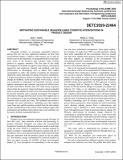Reading the User’s Mind: Designers Show High Accuracy in Inferring Design-Related Thoughts and Feelings
Author(s)
Chang-Arana, Álvaro M; Surma-aho, Antti; Li, Jie; Yang, Maria C; Hölttä-Otto, Katja
DownloadPublished version (1.339Mb)
Publisher Policy
Publisher Policy
Article is made available in accordance with the publisher's policy and may be subject to US copyright law. Please refer to the publisher's site for terms of use.
Terms of use
Metadata
Show full item recordAbstract
© 2020 American Society of Mechanical Engineers (ASME). All rights reserved. The success of design needfinding is largely dependent on how well designers understand their users. It is further claimed that user understanding and designers' capacity to adopt users' perspective, i.e. designers' ability to understand others, are key skills that should lead to successful design outcomes. The general ability to understand someone else's mental contents, such as what they else think, feel, wish, and believe, is called theory of mind. In this study, we connect concepts of humancentered design and theory of mind through empathic accuracy, a performance-based method for measuring empathy. We state two hypotheses. First, that designers are equally accurate at inferring thoughts as they are at inferring feelings. Second, that designers are more accurate in inferring design-related mental contents than those that are not related to design. We answer these hypotheses by analyzing results of altogether 24 designers watching recorded needfinding interviews of 6 users and inferring their mental contents. We observed that feelings were more accurately inferred than thoughts, although the data showed some inconsistencies. A stronger case can be made for designers' accuracy of design-related entries, where designers were consistently more accurate at inferring design-related entries than non-design-related ones. These results provide concrete insight into how designers understand users and how empathy could be quantified in the design context.
Date issued
2020Department
Massachusetts Institute of Technology. Department of Mechanical EngineeringJournal
Proceedings of the ASME Design Engineering Technical Conference
Publisher
ASME International
Citation
Chang-Arana, Álvaro M, Surma-aho, Antti, Li, Jie, Yang, Maria C and Hölttä-Otto, Katja. 2020. "Reading the User’s Mind: Designers Show High Accuracy in Inferring Design-Related Thoughts and Feelings." Proceedings of the ASME Design Engineering Technical Conference, 8.
Version: Final published version